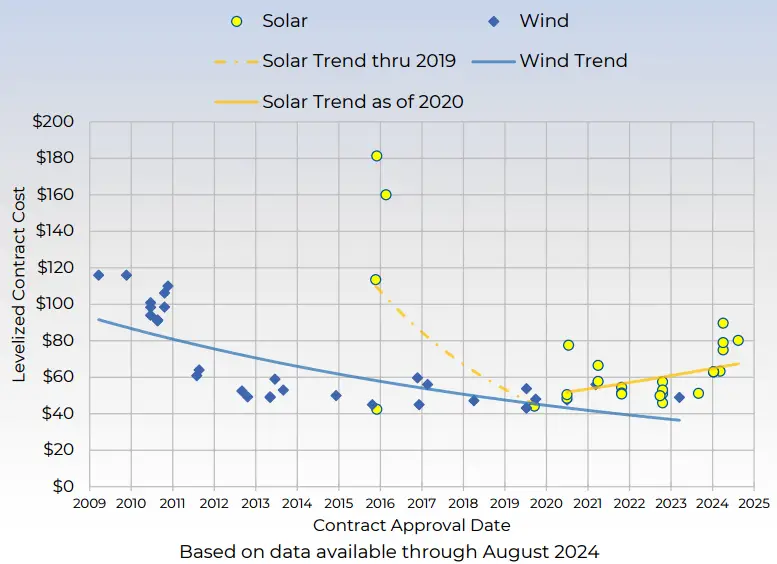Michigan increases renewable energy goals. Sets ambitious targets for wind and solar despite hurdles in project siting and supply chain issues.
Michigan Raises Renewable Energy Portfolio Standards
Michigan has announced increased targets for renewable energy under Public Act 235 of 2023, aiming for 50% renewable energy by 2030 and 60% by 2035. This follows the state’s achievement of a 15% Renewable Portfolio Standard (RPS) in 2021, established under earlier legislation. These goals are part of a broader push to address climate change and transition to cleaner energy sources.
Solar Energy Gains Momentum Despite Hurdles
” class=”wp-image-52289″ style=”width:800px”/>
Portfolio Capacity
Solar energy has emerged as a critical resource for Michigan, overtaking wind farms as the primary renewable energy source for new projects. From 2022 to 2023, renewable energy installations rose by 8.5%, driven by increased customer participation and legislative changes. Distributed Generation (DG) programs, which allow customers to generate their own electricity, have also seen significant growth. DG participation increased by 10.4% in 2023, with nearly 22,000 installations statewide.
However, the transition has not been without challenges. Project delays caused by supply chain disruptions, interconnection queue issues, and local siting conflicts have increased costs and timelines. Despite these obstacles, Michigan is on track to have 8,387 megawatts (MW) of renewable energy capacity by 2026, representing a 42.6% increase from 2023.
Distributed Generation Expands with New Cap
Public Act 235 also raised the cap on DG programs from 1% to 10% of a utility’s average peak load over five years. This tenfold increase is designed to accommodate more residential and commercial projects. The act also allows customers to offset their entire energy bill with outflow credits, enhancing the program’s appeal.
MPSC data shows that DG program installations reached 189,680 kilowatts (kW) in 2023. These programs include both small-scale residential systems (20 kW or less) and larger systems up to 550 kW. Interest in pairing DG with battery storage is growing, with 3,879 customers adding storage capacity totaling 28,560 kW by 2023.
Challenges and Legislative Support
While Michigan’s renewable energy transition is progressing, several barriers remain:
- Local Resistance: Community opposition has delayed several wind and solar projects.
- Supply Chain Issues: Solar panel and battery shortages have slowed installations.
- Regulatory Delays: Extended approval processes for new projects.
To address these, the state enacted Public Act 233 of 2023, granting the MPSC backstop siting authority for large-scale renewable projects. This law aims to streamline approvals and mitigate local opposition.
Michigan Increases Renewable Energy Goals As Prices Drop

The state’s increased RPS requirements have encouraged utilities to expand their voluntary green pricing (VGP) programs. Participation in these programs, which allow customers to purchase renewable energy, has doubled since 2020, reaching over 100,000 customers in 2023. Utilities like DTE Electric and Consumers Energy have committed to significant renewable energy expansions, including thousands of megawatts of new solar capacity by 2030.
Looking ahead, the MPSC is preparing for the first round of clean energy plans required under PA 235, which will outline how utilities will achieve the 100% clean energy target by 2040.
Related Developments
- Energy Storage: Michigan is targeting 2,500 MW of energy storage by 2029 to support renewable energy integration.
- Legislation: Governor Whitmer’s clean energy initiatives aim to reduce greenhouse gas emissions and promote sustainability.
- National Trends: Michigan’s efforts align with broader national goals to combat climate change and increase renewable energy use.
Find More Interesting Feature Stories From ThumbWind
- Michigan Features: Unveiling the people, places, and events that make the Great Lake State unique.
- Weird Political News: A sarcastic take on government news and politics.
- Michigan News: News and events from Michigan’s Upper Thumb region.
Your Turn – Like This, or Hate it – We Want To Hear From You
Please offer an insightful and thoughtful comment. Idiotic, profane, or threatening comments are removed. Consider sharing this story. Follow us to have other feature stories fill up your Newsbreak feed from ThumbWind Publications.



